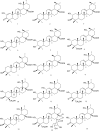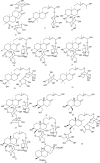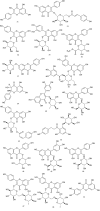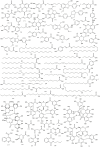Rubus chingii Hu: A Review of the Phytochemistry and Pharmacology
- PMID: 31379574
- PMCID: PMC6646936
- DOI: 10.3389/fphar.2019.00799
Rubus chingii Hu: A Review of the Phytochemistry and Pharmacology
Abstract
Rubus chingii Hu (R. chingii), referred to as "Fu-Pen-Zi" in Chinese, has great medicinal and dietary values since ancient times. The dried fruits of R. chingii have been widely used in traditional Chinese medicine (TCM) for the treatment of kidney enuresis and urinary frequency for centuries. According to current findings, R. chingii has been reported to contain a variety of chemical constituents, mostly triterpenoids, diterpenoids, flavonoids, and organic acids. These compounds have been demonstrated to be the major bioactive components responsible for pharmacological effects such as anticomplementary, anticancer, antioxidant, antimicrobial, and anti-inflammatory functions. Therefore, this review focused on the up-to-date published data of the literature about R. chingii and comprehensively summarized its phytochemistry, pharmacology, quality control, and toxicity to provide a beneficial support to its further investigations and applications in medicines and foods.
Keywords: Rubus chingii Hu; pharmacology; phytochemistry; quality control; toxicity.
Figures









Similar articles
-
Bioactive components, pharmacological effects, and drug development of traditional herbal medicine Rubus chingii Hu (Fu-Pen-Zi).Front Nutr. 2023 Jan 9;9:1052504. doi: 10.3389/fnut.2022.1052504. eCollection 2022. Front Nutr. 2023. PMID: 36698464 Free PMC article. Review.
-
Rubus chingii Hu: an overview of botany, traditional uses, phytochemistry, and pharmacology.Chin J Nat Med. 2020 Jun;18(6):401-416. doi: 10.1016/S1875-5364(20)30048-0. Chin J Nat Med. 2020. PMID: 32503732
-
Bioactive comparison of main components from unripe fruits of Rubus chingii Hu and identification of the effective component.Food Funct. 2015 Jul;6(7):2205-14. doi: 10.1039/c5fo00406c. Food Funct. 2015. PMID: 26053738
-
The chromosome-scale reference genome of Rubus chingii Hu provides insight into the biosynthetic pathway of hydrolyzable tannins.Plant J. 2021 Sep;107(5):1466-1477. doi: 10.1111/tpj.15394. Epub 2021 Aug 10. Plant J. 2021. PMID: 34174125
-
Diterpenoid glucosides with anti-inflammatory activity from Rubi Fructus.Fitoterapia. 2023 Jan;164:105325. doi: 10.1016/j.fitote.2022.105325. Epub 2022 Oct 29. Fitoterapia. 2023. PMID: 36448845
Cited by
-
Two triterpenoids from Rubus fraxinifolius leaves and their tyrosinase and elastase inhibitory activities.Sci Rep. 2021 Oct 14;11(1):20452. doi: 10.1038/s41598-021-99970-x. Sci Rep. 2021. PMID: 34650166 Free PMC article.
-
Rosmarinic acid, the active component of Rubi Fructus, induces apoptosis of SGC-7901 and HepG2 cells through mitochondrial pathway and exerts anti-tumor effect.Naunyn Schmiedebergs Arch Pharmacol. 2023 Dec;396(12):3743-3755. doi: 10.1007/s00210-023-02552-z. Epub 2023 Jun 20. Naunyn Schmiedebergs Arch Pharmacol. 2023. PMID: 37338574 Free PMC article.
-
Untapped potential of non-conventional rubus species: bioactivity, nutrition, and livelihood opportunities.Plant Methods. 2023 Oct 27;19(1):114. doi: 10.1186/s13007-023-01094-y. Plant Methods. 2023. PMID: 37891607 Free PMC article. Review.
-
Antibacterial effect of Rubus chingii flower extract against multidrug-resistant bacteria.Bioinformation. 2022 Oct 31;18(10):938-942. doi: 10.6026/97320630018938. eCollection 2022. Bioinformation. 2022. PMID: 37654834 Free PMC article.
-
The anticancer activity and mechanisms of She medicine herbs.Front Pharmacol. 2025 Jul 17;16:1610301. doi: 10.3389/fphar.2025.1610301. eCollection 2025. Front Pharmacol. 2025. PMID: 40746719 Free PMC article. Review.
References
-
- Cao F., Qiu X. X., Zhang L., Wang Y. Y. (2017). Determination of three triterpene acids in Rubi Fructus by reverse-phase high-performance liquid chromatography. J. Anhui. Univ. Chin. Med. 36, 79–82. 10.3969/j.issn.2095-7246.2017.04.023 - DOI
-
- Chai W. (2008). Studies on the chemical constituents and quality standard of Rubus chingii Hu. Ph.D Thesis. Beijing, China: China Academy of Chinese Medical Science.
Publication types
LinkOut - more resources
Full Text Sources

